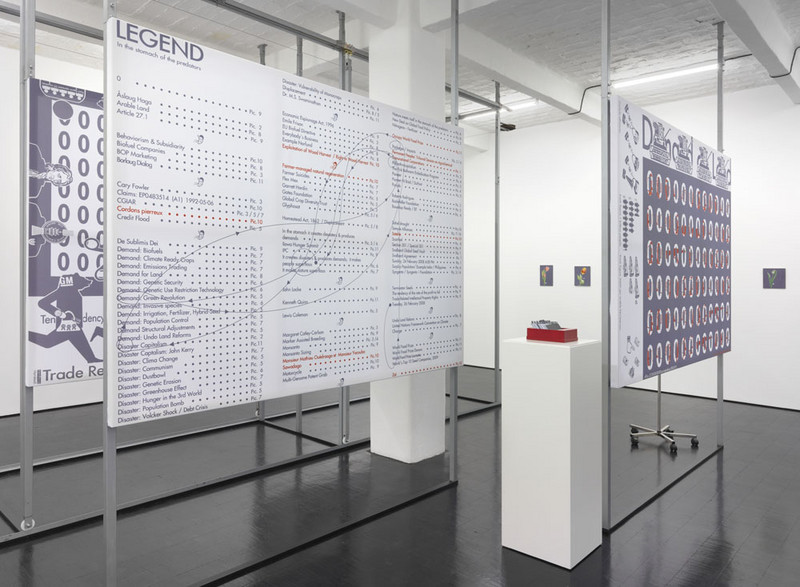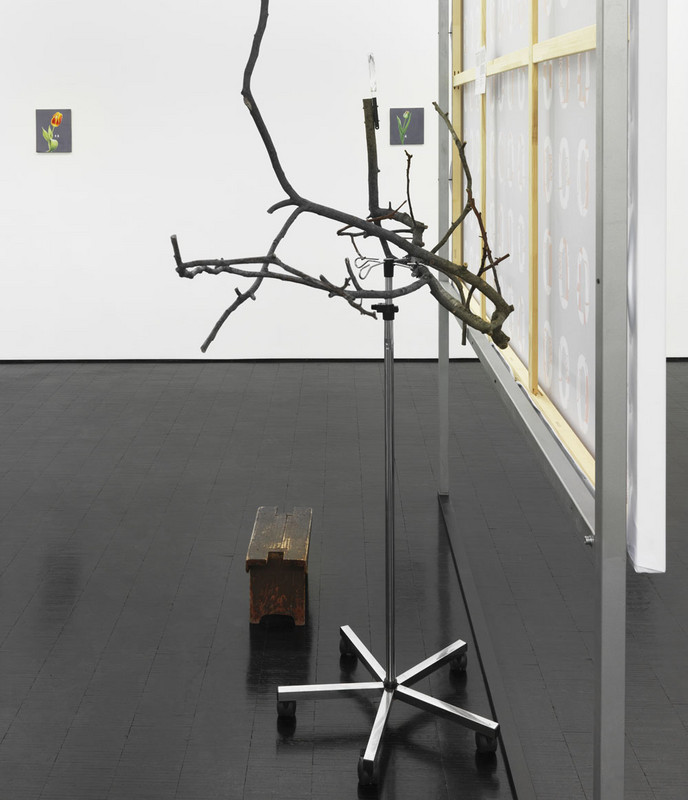In the Stomach of the Predators
01 Mar - 26 Apr 2014
Press Release
Andreas Siekmann
In the Stomach of the Predators
March 1, 2014 – April 26, 2014
Opening Friday 28 February, 6–9 pm
Gallery hours, Tue–Sa, 11 am – 6 pm
In 1842 the young Karl Marx observed the Rhineland Parliament’s debate on toughening the law on the theft of wood. While forests were publicly accessible, they did belong to somebody, and most members of the Rhineland Parliament viewed it as a criminal offence for the poor to gather dry twigs and branches there. Marx reflected on how the capitalist mode of production had always drawn its foremost boundaries between those who made laws and those who had to follow them. The first of these boundaries were to be understood very literally: territories were demarcated, other countries and even whole continents were subjugated and parcelled out. Natural resources and the people who lived in these countries became the object of private business interests and trade. In a very real sense, this history of conquest ends with the devouring of these goods. People face off against one another like animals in the wild. In the end nature encounters itself in the stomach of the predators.
The central installation of Andreas Siekmann’s show is entitled In the Stomach of the Predators... Large-scale panels, which the viewer can move, survey the current state of these ever-progressing developments and elucidate the disruptions that both state endeavours and private businesses cause through their dealings with the common good that is nature. The Svalbard Global Seed Vault, the seed bank established by governments and agribusinesses in permanent ice on the Norwegian island of Spitsbergen, is just one of the nodal points in a global web whose pathways pump knowledge, genetic information and the fruits of centuries of experience from the Global South to the industrialised nations in an incessant blood-letting. Genetically modified seeds flow back in the other direction, binding local populations to the agriculture industry’s products. In complex diagrams composed of many pictograms that he developed himself, Siekmann approaches this subject matter inventively, with biting humour and unwavering faith in the power of representation.
7. Februar 1637, a series of Siekmann’s tulip pictures painted from nature, broadens the exhibition to bring a further aspect of the subject into play: like votive offerings, these botanical portraits form a gathering of silent witnesses, alluding to the role of art in these events.
In his long-term drawing series, installations and architectural models, the Berlin-based artist Andreas Siekmann engages frequently with the privatisation of public property and the restructuring of labour relations under the conditions of globalisation. Using formally broad-ranging working methods that converge into highly personal imagery, Siekmann focuses on the question of representation: how can we grasp these processes and find images for circumstances that all too often succumb to abstraction? Andreas Siekmann attained international renown through his participation in documenta XI (2002) and XII (2007), as well as the Skulptur Projekte Münster (2007).
In the Stomach of the Predators arose from a collaboration between Andreas Siekmann and Alice Creischer that was shown last year at Biennale Regard Benin in Cotonou, at Bergen Assembly in Bergen, and at the Istanbul Biennale in Istanbul. An Alice Creischer solo exhibition at KOW is running parallel to this exhibition of Andreas Siekmann’s work.
A catalogue titled Die Exklusive. Zur Politik des ausgeschlossenen Vierten will be published this March by Verlag der Buchhandlung Walther König, Cologne; with contributions by Clemems Krümmel, Andreas Siekmann and Sophie Goltz.
Andreas Siekmann
In the Stomach of the Predators
March 1, 2014 – April 26, 2014
Opening Friday 28 February, 6–9 pm
Gallery hours, Tue–Sa, 11 am – 6 pm
In 1842 the young Karl Marx observed the Rhineland Parliament’s debate on toughening the law on the theft of wood. While forests were publicly accessible, they did belong to somebody, and most members of the Rhineland Parliament viewed it as a criminal offence for the poor to gather dry twigs and branches there. Marx reflected on how the capitalist mode of production had always drawn its foremost boundaries between those who made laws and those who had to follow them. The first of these boundaries were to be understood very literally: territories were demarcated, other countries and even whole continents were subjugated and parcelled out. Natural resources and the people who lived in these countries became the object of private business interests and trade. In a very real sense, this history of conquest ends with the devouring of these goods. People face off against one another like animals in the wild. In the end nature encounters itself in the stomach of the predators.
The central installation of Andreas Siekmann’s show is entitled In the Stomach of the Predators... Large-scale panels, which the viewer can move, survey the current state of these ever-progressing developments and elucidate the disruptions that both state endeavours and private businesses cause through their dealings with the common good that is nature. The Svalbard Global Seed Vault, the seed bank established by governments and agribusinesses in permanent ice on the Norwegian island of Spitsbergen, is just one of the nodal points in a global web whose pathways pump knowledge, genetic information and the fruits of centuries of experience from the Global South to the industrialised nations in an incessant blood-letting. Genetically modified seeds flow back in the other direction, binding local populations to the agriculture industry’s products. In complex diagrams composed of many pictograms that he developed himself, Siekmann approaches this subject matter inventively, with biting humour and unwavering faith in the power of representation.
7. Februar 1637, a series of Siekmann’s tulip pictures painted from nature, broadens the exhibition to bring a further aspect of the subject into play: like votive offerings, these botanical portraits form a gathering of silent witnesses, alluding to the role of art in these events.
In his long-term drawing series, installations and architectural models, the Berlin-based artist Andreas Siekmann engages frequently with the privatisation of public property and the restructuring of labour relations under the conditions of globalisation. Using formally broad-ranging working methods that converge into highly personal imagery, Siekmann focuses on the question of representation: how can we grasp these processes and find images for circumstances that all too often succumb to abstraction? Andreas Siekmann attained international renown through his participation in documenta XI (2002) and XII (2007), as well as the Skulptur Projekte Münster (2007).
In the Stomach of the Predators arose from a collaboration between Andreas Siekmann and Alice Creischer that was shown last year at Biennale Regard Benin in Cotonou, at Bergen Assembly in Bergen, and at the Istanbul Biennale in Istanbul. An Alice Creischer solo exhibition at KOW is running parallel to this exhibition of Andreas Siekmann’s work.
A catalogue titled Die Exklusive. Zur Politik des ausgeschlossenen Vierten will be published this March by Verlag der Buchhandlung Walther König, Cologne; with contributions by Clemems Krümmel, Andreas Siekmann and Sophie Goltz.





